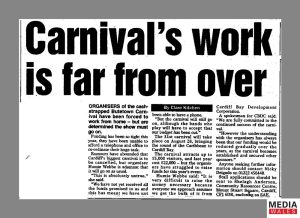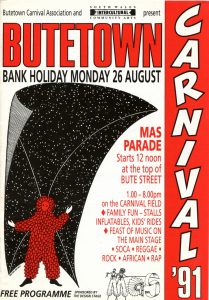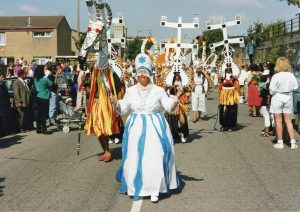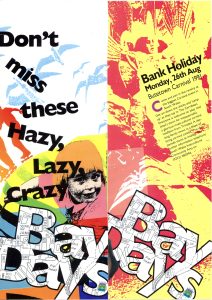1990s: Decline Amid Funding Struggles and Redevelopment
 Butetown Carnival drew large crowds in the early 1990s, even as funding began to dry up (1992 scene pictured). In the early 1990s, Cardiff’s iconic Butetown Carnival, which had once rivalled Notting Hill in scale, drawing tens of thousands in its heyday, began to falter due to chronic funding shortages. This downturn coincided with the massive Cardiff Bay redevelopment transforming Tiger Bay. The carnival had long been a key date in the community’s calendar and even “survived big changes in Butetown” as regeneration projects took off around it. However, the new corporate involvement in the Bay’s renewal created tensions. Organisers recall that the Cardiff Bay Development Corporation (CBDC) – the agency spearheading docklands redevelopment – attempted to take over and commercialise the event, prompting pushback from locals. In response, a group of Butetown residents (including a young Keith Murrell) formed Tiger Bay Community Arts in the early ’90s to keep the Carnival community-run. “The people redeveloping Cardiff Bay wanted to try [to] run Butetown Carnival and take it out of the hands of the community,” Murrell later explained. His volunteer collective managed to revive the carnival and inherit some seed funding, but the money ran out after three years. By the mid-90s, the community grew disheartened as they competed with other well-funded cultural events in the city that often overlooked Butetown’s Black artists.
Butetown Carnival drew large crowds in the early 1990s, even as funding began to dry up (1992 scene pictured). In the early 1990s, Cardiff’s iconic Butetown Carnival, which had once rivalled Notting Hill in scale, drawing tens of thousands in its heyday, began to falter due to chronic funding shortages. This downturn coincided with the massive Cardiff Bay redevelopment transforming Tiger Bay. The carnival had long been a key date in the community’s calendar and even “survived big changes in Butetown” as regeneration projects took off around it. However, the new corporate involvement in the Bay’s renewal created tensions. Organisers recall that the Cardiff Bay Development Corporation (CBDC) – the agency spearheading docklands redevelopment – attempted to take over and commercialise the event, prompting pushback from locals. In response, a group of Butetown residents (including a young Keith Murrell) formed Tiger Bay Community Arts in the early ’90s to keep the Carnival community-run. “The people redeveloping Cardiff Bay wanted to try [to] run Butetown Carnival and take it out of the hands of the community,” Murrell later explained. His volunteer collective managed to revive the carnival and inherit some seed funding, but the money ran out after three years. By the mid-90s, the community grew disheartened as they competed with other well-funded cultural events in the city that often overlooked Butetown’s Black artists.
Local creativity on display – community participants carrying a dragon puppet during the 1991 Butetown Carnival fun run. Despite these headwinds, the Carnival persevered through the mid-1990s due to grassroots efforts. Annual August bank holiday parades still drew up to 15,000 visitors, but finances were extremely tight. Organisers operated on a shoestring budget – in 1995, they could not even afford an office or telephone, working from home to plan the event. “Rumours have abounded that Cardiff’s biggest carnival is to be cancelled,” reported the South Wales Echo in July 1995, but organiser Humie Webbe was adamant the show would go on. “This is untrue… the carnival will still go on, although the bands who play will have to accept that our budget has been cut,” Webbe insisted, determined to keep the tradition alive. She highlighted the difficulty of raising the roughly £22,000 needed each year, especially since many assumed the redevelopment authorities bankrolled the Carnival. In reality, the CBDC’s sponsorship was being scaled back yearly – a CBDC spokesperson noted their funding was always meant to be “reduced gradually over the years, as the carnival… secured other sponsors.” This left organisers scrambling to fill the gap, with dwindling sponsorship and donations in a period of economic and political change for Butetown.



By the late 1990s, the strain became too great. Cardiff’s expanding summer events calendar – boosted by the revamped Bay’s image – drew attention and funding elsewhere, and Butetown Carnival struggled to compete. In 1998, the carnival was finally halted after decades of annual celebrations. “1998 saw the last Butetown Carnival of the 20th century,” as one retrospective notes, citing a combination of factors including funding shortfalls and competition from other festivals in the city. After that August, no carnival occurred, ending a 31-year run and leaving a void in the community. The beloved event would not return for 16 years, as efforts to restart it stalled amid the redevelopment era’s challenges. This long hiatus (1998–2014) underscored the impact of losing institutional support for a grassroots cultural tradition. Only in the 2010s would determined locals like Keith Murrell regroup to finally bring back Butetown Carnival, restoring its spirit for a new generation after a decade and a half of absence.



